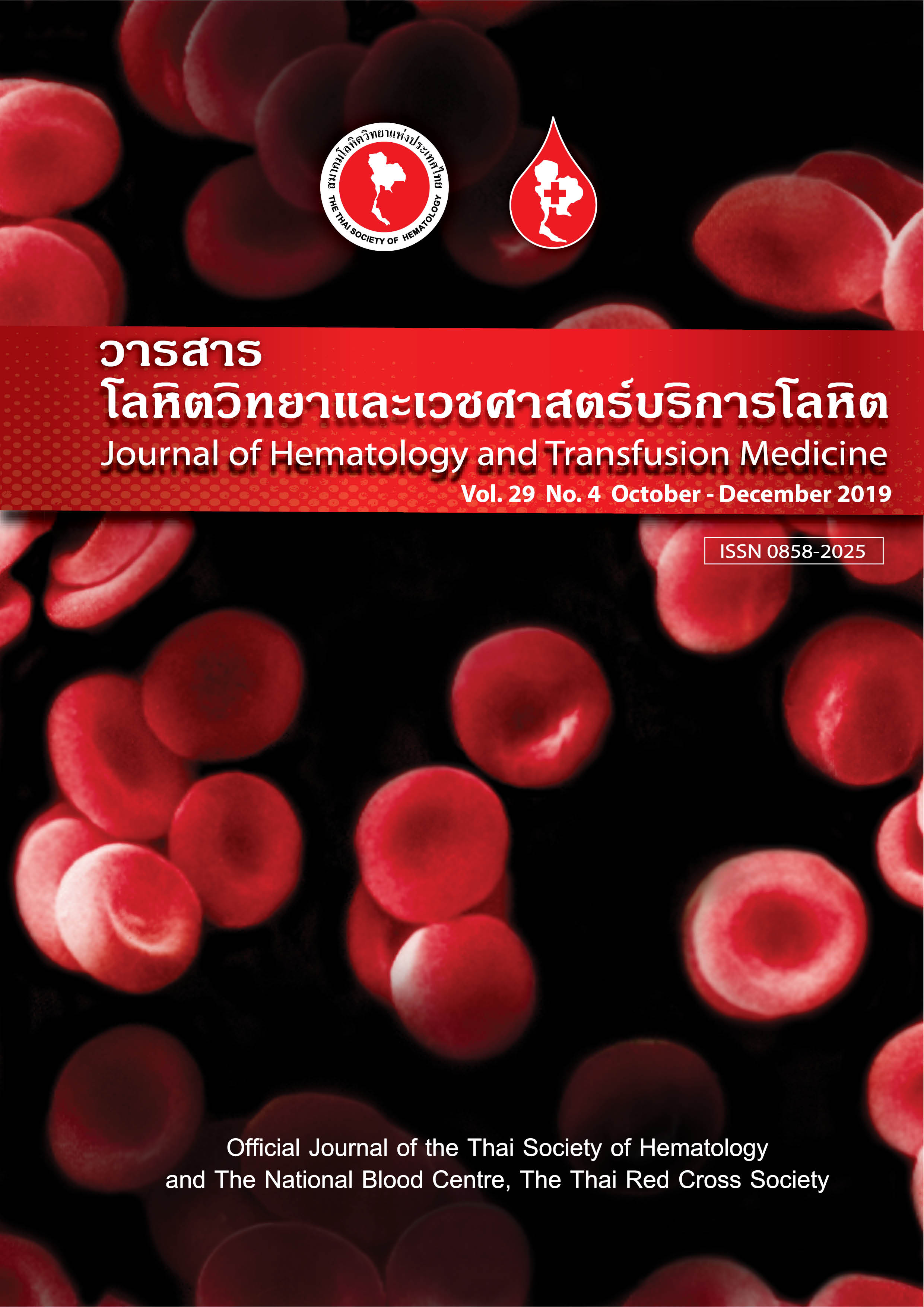The prevalence of red cell antibodies among patients and pregnant women in Pakchongnana Hospital
Keywords:
Red cell antibodies, Patients, Pregnant women, แอนติบอดีต่อเม็ดเลือดแดง, ผู้ป่วย, หญิงตั้งครรภ์Abstract
Abstract:
Background: The antibody screening test is an essential component of pretransfusion testing before blood transfusion. Antibody identification must be performed to determine antibody specificity in case of positive antibody screening. Limited data are available on the prevalence of red cell antibodies among patients and pregnant women from lower northeastern Thailand. This study aimed to determine the prevalence of red cell antibodies among patients and pregnant women in Pakchongnana Hospital. Materials and Methods: Blood samples from 601 pregnant women and 2,488 patients were tested using antibody screening by standard tube technique (STT). Positive samples were determined for antibody specificity and analyzed according to sex, age groups, ABO and Rh types. Moreover, red cell genotyping was performed in samples with positive autocontrol. Results: The prevalence of antibodies among pregnant women and patients was 1.33% and 1.89%, respectively. The frequencies of positive red cell antibodies were significantly higher among patients ≥ 40 years (p = 0.036), belonging to a single antibody (57.4%), multiple antibodies (12.8%) and unidentified antibodies (29.8%). Anti-Mia was the most common in the two groups, followed by anti-P1, anti-E, anti-Lea and anti-Leb. Additionally, for 2 patients having anti-Mia, the predicted phenotypes were confirmed to be Mi(a-) using multiplex PCR. Conclusion: This is the first report of the prevalence of red cell antibodies among patients and pregnant women in Pakchongnana Hospital, which attempted to provide red cell antigens that, have the potential for alloantibody formation. Hence, the prompt management of donor blood units corresponding to this data could be applied to ensure safer blood transfusions.
Downloads
References
2. National Blood Centre, Thai Red Cross Society. Standards for blood banks and transfusion service. 4thed. Bangkok: Udomusksa; 2015.
3. Chow EYD. The impact of the type and screen test policy on hospital transfusion practice. Hong Kong Med J. 1999;5:275-9.
4. White J, Qureshi H, Massey E, Needs M, Byrne G, Daniels G, et al. Guideline for blood grouping and red cell Antibody testing in pregnancy. Transfus Med. 2016;26:246-63.
5. Semmekrot BA, de Man AJ, Boekkooi PF, van Dijk BA. Irregular blood group antibodies during pregnancy: screening is mandatory. [in Dutch]. Ned Tijdschr Geneeskd. 1999;143:449-52.
6. Pahuja S, Gupta SK, Pujani M, Jain M. The prevalence of irregular erythrocyte antibodies among antenatal women in Delhi. Blood Transfus. 2011;9:388-93.
7. Sinkitjasab A, Chanta P, Thienthaworn J. Prevalence of unexpected antibodies in transfused patients and pregnant women at Taksin Hospital. J Hematol Transfus Med. 2016;26:347-55.
8. Bejrachandra S, Saipin J, Nathalang O, Siriboonrit U, Rungroung E, Udee S. External quality assessment scheme in red blood cell serology: a 5-year experience in Thailand. Immunohematology. 2006;22:1-5.
9. Intharanut K, Bejrachandra S, Nathalang S, Leetrakool N, Nathalang O. Red cell genotyping by multiplex PCR identifies antigen-matched blood units for transfusion-dependent Thai patients. Transfus Med Hemother. 2017;44:358-64.
10. Hamilton JR. Common and frequently encountered antibodies. Transfus Apher Sci. 2009;40:189-94.
11. Patidar GK. Antibody screening of healthy blood donors: It’s time to make it mandatory. J Blood Disorders Transf. 2015;6:245.
12. Pongernnak P, Sasjeenpong S, Chuesakul K, Pangwangthong K. The prevalence of red cell alloantibodies in lower northern Thailand. J Med Assoc Thai. 2016;99:1337-43.
13. Lee CK, Ma ES, Tang M, Lam CC, Lin CK, Chan LC. Prevalence and specificity of clinically significant red cell alloantibodies in Chinese women during pregnancy-a review of cases from 1997 to 2001. Transfus Med. 2003;13:227-31.
14. Nathalang O, Kuvanont S, Punyaprasiddhi P, Tasaniyanonda C, Sriphaisal T. A preliminary study of the distribution of blood group systems in Thai blood donors determined by the gel test. Southeast Asian J Trop Med Public Health. 2001;3:204-7.
15. Bejrachandra S, Nathalang O, Saipin J, Kuvanont S, Wichitchinda K, Vongpattranon A. Distribution of blood group systems in Thai blood donors determined by the gel test. Siriraj Hosp Gaz. 2002;54:403-9.
16. Fongsarun J, Nuchprayoon I, Yod-in S, Kupatawintu P, Kidprasirt C. Blood groups in Thai blood donors. J Hematol Transfus Med. 2002;12:277-86.
17. Chandanayingyong D, Sasaki TT, Greenwalt TJ. Blood groups of the Thais. Transfusion. 1967;7:269-76.
18. Murao M, Viana MB. Risk factors for alloimmunization by patients with sickle cell disease. Braz J Med Biol Res. 2005;38:675-82.
19. Kupatawintu P, Emthip M, Sungnoon D, O-vataga P, Manakul V, Limtamaporn S, et al. Unexpected antibodies of patients, blood samples sent for testing at NBC, TRCS. J Hematol Transfus Med. 2010;20:255-62.
20. Srijinda S, Bosuwan S, Nuanin C, Suwannasophon C. Anti-Mia and anti-E: the most common clinically significant red cell alloantibodies in patients at Phramongkutklao Hospital. RTA Med J. 2017;70:65-71.
21. Butryojantho C, Junta N, Pimphumee R, Srichai S, Darunikorn P, Puapairoj C, et al. Antibody screening and the prevalence of unexpected antibodies in patients of Srinagarind Hospital. J Hematol Transfus Med. 2017;27:27-33.
22. Höglund P, Rosengren-Lindquist R, Wikman AT. A severe haemolytic transfusion reaction caused by anti-Le(a) active at 37°C. Blood Transfus. 2013;11:456-9.



